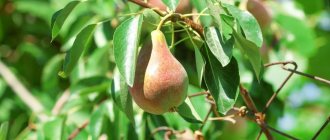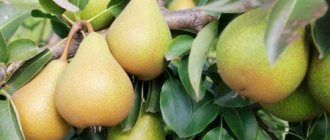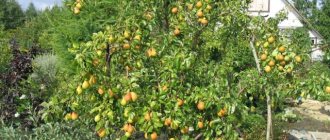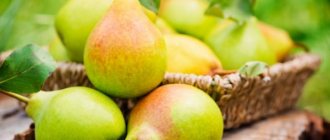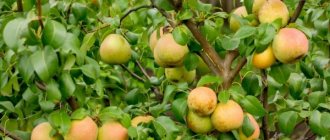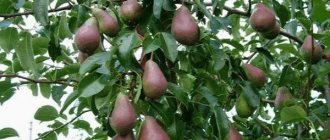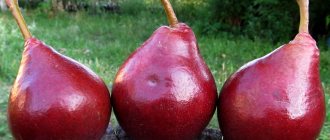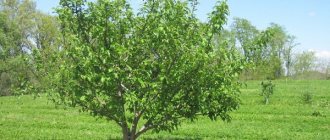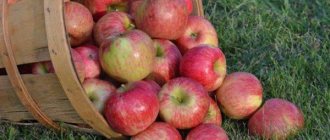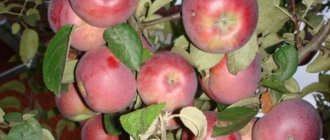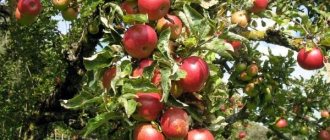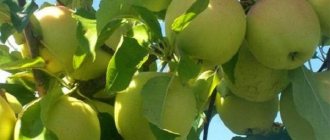Gardening » Pear
0
1458
Article rating
Kira Stoletova
Parisian pear is unpretentious in care. The Parisian plant quickly takes root in fertile soils that warm up well in early spring.
Description of the Parisian pear variety
History of variety development
The variety was created more than 100 years ago by the French breeder Fursin V. In the process of work, the varieties Curé and Saint Germain winter were crossed. Now it is distributed throughout Europe. The tree can withstand slight frosts in winter, so it is grown in the southern regions and central part of Russia.
The resulting tree is distinguished by attractive fruits with high commercial characteristics . The fruits are considered universal and are suitable for both homemade preparations and fresh consumption.
Diseases of the variety
The pear variety is resistant to common diseases of garden crops. The main threat is scab. The causative agent of the disease is a marsupial fungus. The disease manifests itself on the inflorescences, after which they wither and fall off. Scab spreads on the foliage: spots appear that do not go away.
The last stage of the disease is characterized by spots on the fruit. If you do not carry out timely prevention - spraying with special solutions - you will not be able to reap a good harvest.
Disease Control
Spraying is used to kill the infection. The first step is to tear off and burn the affected leaves away from garden crops. The remaining foliage is treated with a urea solution for prevention.
Bordeaux mixture is suitable for spraying a young tree. It is diluted according to the following scheme: for 300 g of copper sulfate, take 400 g of lime. The dry mixture is diluted in 10 liters of purified water.
The Parisian pear is very popular among gardeners. This variety is one of the oldest varieties of pears, which are famous for their taste and appearance. Today I will tell you about the characteristics of this wonderful fruit and what you need to do if you decide to grow such a pear tree in your dacha.
A long time ago, this pear was bred by combining the varieties “Saint-Germain Winter” and “Cure”, so what positive characteristics of these varieties did “Parisian” adopt? A detailed description of these characteristics is given below.
Description and characteristics of the tree
A distinctive feature of this tree is its powerful pyramidal crown. Long, straight, dark yellow shoots are characterized by moderate foliage and high growth vigor. With age, the color of the shoots darkens and becomes gray.
Its fruits are pleasant to the taste, sweet, with a slight sourness. These pears have an elongated shape, bright yellow color and a faint aroma. As it ripens, the peel becomes lighter and some areas begin to turn red. When the fruit ripens, its peel becomes covered with small spots.
Dense and moderately juicy pulp is one of the distinctive features of the variety . The weight of one fruit is 150–200 g. The commercial properties of the Parisian fruit are quite high. The dense peel does not deform or crack. And at the same time, it tastes just as pleasant as the pulp.
Pollination, fruiting and ripening period
The variety is self-fertile. This means that it does not need pollinators to produce fruits. This pear pollinates its flowers with its own pollen. But self-fertility of trees is not a permanent feature and in some regions such trees can become partially self-fertile.
This leads to a reduction in yield to 20–30% of the flowering mass. Therefore, if the space allows, then it is worth planting another pear nearby with the same flowering time. This will allow you to save 100% of the harvest. Varieties Motley July, Charno, Bere Ligelya are suitable as pollinators.
Important! Fruits can be stored at 0
°
C until February, which is an undeniable advantage of the Parisian.
Parisian fruiting begins already in the 3rd year, after which the pear begins to increase its yield. Fruit harvesting occurs in October. As a rule, pears are not allowed to ripen on the tree to preserve their firmness and marketability. If the pulp becomes loose, the fruit will not be able to be stored for long.
Productivity
The average pear tree produces fruit 100–115 days after flowering. The average yield of the variety will be about 100 kg of pears per tree.
But obtaining a harvest depends not only on the declared yield, but also on the growing conditions of the pear and its care. It will take about 15 years for pears to reach maximum production as well as size.
Winter hardiness
Self-fertile varieties are not winter hardy. During severe frosts, ice forms in plant tissues, which leads to damage to branches, roots and trunk. The recovery of the pear does not occur too quickly. Therefore, grow pears in regions whose climate is suitable for it: in the central regions of Russia, southern regions, the Baltic states, Moldova, Belarus, Ukraine.
Important! Winter hardiness may change with the age and overall development of the plant. Thus, young trees are less resistant to frost than old ones.
The most destructive for plants are sharp short-term frosts, as well as “ice” rains. Precipitation that freezes as ice on the branches damages the buds and prevents the tree from flowering and bearing fruit this year.
Pros and cons of the variety
- Advantages of the variety:
- high productivity;
- excellent tasting characteristics;
- good commercial properties of the fruit.
- Disadvantages of the variety:
- low winter hardiness;
- insufficient resistance to diseases;
- decreased yield in unfavorable weather;
- demands on soil.
Winter ripening pear varieties also include Kyrgyz Winter, Concord and Belorussian Late.
What care is needed?
This variety of pear is not an overly whimsical variety, so caring for it is quite simple. It includes forming the crown, watering the plants on a regular basis, weeding so that weedy plants do not take away their nutrients, as well as carrying out preventive measures that will get rid of harmful insects and various diseases.
When watering, it is very important not to forget the following:
- Watering is done only when truly necessary. Important! The frequency of watering largely depends on the type of soil used;
- if the weather is very hot outside, then watering should be twice as abundant as usual;
- If you are feeding the plant and the weather is hot outside, then before directly feeding you will need to generously spill the soil with water.
When feeding pears, it is important to follow these rules:
- in the summer months, it is recommended to fertilize the plant with fertilizers that contain phosphorus and potassium, since during these periods these substances will be lacking the most;
- When adding fertilizers in the spring, you need to ensure that the fertilizers do not come into direct contact with the root system. Important! Foliar feeding has a very positive effect on the plant.
When performing pruning, remember the following:
- pruning should be done annually; this is what ensures that the tree develops healthy and produces a good harvest;
- in the spring, direct pruning is performed, in the autumn, sanitary cleaning is performed. Important! At the very beginning of the spring period, it is worth treating the tree with special means so that pests cannot cause damage to it.
Features of planting a pear
Planting a pear is almost no different from other trees, but there are a number of rules that need to be taken into account. Start by preparing the area. Avoid wetlands and low-lying areas where cold air stagnates. The soil should also be permeable to air, which means it should be loamy or sandy.
The spacing between pear trees depends on the variety (i.e. the final size of the mature tree). Distances vary from 6x4 m to 2x2 m for dwarf breeds. If you are planting 2 trees that must participate in pollination, then there should be no more than 6 m between them.
Favorable growing conditions
Most pears need a sunny area. It should receive enough sun - at least 6-8 hours a day and have well-drained soil. Planting occurs in early spring. European pears generally grow best in plant hardiness zones 5–8.
Did you know? The Chinese considered the pear a symbol of immortality. The destruction of a pear tree symbolized a tragic or untimely death.
They allow winter temperatures from –12°С to –27°С. This zone includes European countries, Ukraine, the Baltic states, Belarus and almost the entire territory of Russia with the exception of the northern regions. Varieties of Asian origin best tolerate winter at temperatures from –1°C to –7°C.
Planting stages
Before planting, soak the roots of the seedling in water for 2–4 hours. And then coat them with clay mash. The water will help them straighten out and reduce the likelihood of damage when planting. And clay will protect against soil fungi.
Soaking the roots of a seedling in a clay mash
Planting technology:
- Clear the area of weeds and level the soil.
- Make a hole 1x1 m.
- Place 1 bucket of manure at the bottom.
- Cover it with a layer of soil.
- Place a seedling in the center of the hole.
- Add soil and compact it.
- Do not level the soil to the horizon level. Leave a small edge around the edge to retain moisture in the hole when watering.
- Water the seedling.
Watering will be required 2-3 more times within a week after planting. This is necessary so that the soil subsides and air pockets disappear if they accidentally formed during planting.
Landing rules
If you decide to grow this variety of fruit at your dacha, then in addition to the well-known rule that you should plant this pear in the fall, gardeners need to remember some more points. If you follow them, the pear will always delight you with its healthy appearance and large amount of harvest. And if you don’t comply, problems may arise that will take a lot of time to resolve.
These important rules to follow include the following:
- It is best to plant seedlings that have reached two years of age;
- When choosing a seedling, you need to check that it is strong enough for planting. In strong seedlings, growth reaches up to 1.3 m, the stem part is approximately 1 cm;
- Before planting plants, it is necessary to first prepare the soil. This will allow the plants to take root better;
- the depth of the hole dug for the seedling should not exceed 1 m;
- it is necessary to place a nutrient-type mixture in the hole (high-quality soil + peat + rotted manure);
- if before planting you notice that the roots have become somewhat dry, then you need to place the plant for 24 hours in water in which a specialized stimulant is diluted;
- if plants with a powerful crown part are planted, then it is worth creating a space of at least 5 meters between them, then they will be able to develop safely, receiving all the necessary nutrients for themselves;
- It is recommended to plant the seedling at some elevation, as this will have a positive effect on its development;
- after planting, you must straighten the roots of the plant and, if necessary, sprinkle them with soil containing nutritious soil;
- water the plant;
- mulch the soil;
- tie the seedling to a support type peg.
Important! After these steps are completed, you will need to provide the seedling with the necessary care, otherwise you will not see the harvest soon. See below for information on how to complete this task.
Features of pear care
Once planted, the tree does not require daily care and attention.
But you will have a number of mandatory periodic events:
- watering;
- pruning;
- fertilization;
- disease prevention.
Did you know? Pears are considered hypoallergenic, since allergies to this fruit are very rare. But it is possible for those who are allergic to alder or birch pollen.
You will also need to periodically clean the garden: remove weeds, loosen the soil, remove carrion and fallen leaves.
Watering
Watering depends on the age of the pear, as well as climatic conditions. A young tree needs to be watered 1-2 times a week. The best watering system for pear trees is sprinkling, in which water falls on the plants through a rotating or standing sprayer with many small holes, simulating real rain.
If this is not possible, make a groove 15 cm wide around the tree trunk and carefully pour water into it.
An adult pear does not need such frequent watering. You can provide it with deep watering once a month or even less often.
The root system of an adult pear is able to obtain water from deeper layers of soil. Watering begins in the spring and continues until October. In autumn, the tree should become lignified and get rid of excess moisture in the tissues. This helps reduce damage during sudden temperature changes in winter.
Did you know? Pear wood is used to make furniture, musical instruments and wood carvings. It is quite durable and does not deform over time.
Trimming
Until the pear tree enters the fruiting phase, do not prune. Start it when the seedling reaches the age of 4 years. Winter is the time to prune freestanding pear trees. The purpose of pruning is to form the crown and remove damaged or dry branches.
The pear tree will remain dormant until March, so you can prune it any day from November to March. Pruning can also be done in summer. It is practiced for trees that are grown in the form of cordons or trellises.
To limit the height of the pear, trim the top to 0.7 m when the seedling reaches a height of 1 m. This stimulates the formation of side shoots and makes the tree easier to care for. Scheme for pruning a young thickened pear tree:
1 — isolation of the leader (a); subordination of the main branches (b); thinning (c); pruning drooping branches (d); 2 - tree after pruning.
Trimming technique:
- remove any branches that intersect with other branches, creating crowding;
- remove dry or damaged branches;
- if the shape of the tree has already been formed, then instead of pruning, the side shoots are shortened;
- identify the main branches and reduce their length by a third in winter by making an oblique cut above an outward-facing bud;
- side shoots on the main branches should be left alone in winter; in summer these shoots are pruned to three leaves above the growing point;
- if new secondary growth appears in September, remove it.
For pruning, you can use pruning shears, a saw or a lopper. Before you start cutting, carefully inspect the pear and outline what you are going to do so that you do not cut off anything unnecessary.
Video: spring pruning of pear
Pear fertilizer
Pears are fertilized before the buds open, i.e. in early spring. If you do not have time to fertilize them at this time, then it is not dangerous. Feeding can be carried out until June. At the end of summer and autumn, fertilizing is no longer applied. If you do this, new growth of branches will begin, which will immediately die during the frost.
Did you know? The ancient Romans described about 30 varieties of pears. Now there are 100 times more of them.
Fertilizer application should increase productivity, resistance to pests and diseases, and enhance growth energy. Test your soil to know exactly what micronutrients need to be added. If you have nothing to check it with, then focus on growth. It should be 25–30 cm per year. If this is not the case, then the tree needs fertilizer.
All fruit trees require nitrogen to grow, increase leaf mass and enhance photosynthesis. Excess nitrogen is harmful, it causes leaves to grow and prevents the tree from forming fruit ovaries. Pears that are located next to lawns are also fertilized moderately, since the roots will receive the missing substances from the fertilizers applied to the lawn. Pears also need potassium and phosphorus. It stimulates the development of roots and flowers. Apply fertilizer around the perimeter of the crown.
The tree receives nutrients from the peripheral part of the roots, so they will be absorbed faster than those added near the trunk. The easiest method for fertilizing a pear tree is to use a balanced 13-13-13 fertilizer. Spread the fertilizer around the circle and then water it. An adult tree needs about 200 g of fertilizer per 1 m². A quarter of this dose is suitable for a young seedling.
Growing pear
Seedling preparation
The Parisian pear variety is planted in the fall. Two-year-old seedlings take root best. The average height of such a seedling is 1.2 m, and the thickness is no more than 1 cm. Material with 3-4 well-developed roots is suitable for planting.
Good results with healthy seedlings
The length of the root system is 18-20 cm and is suitable for planting in any region: it is best to choose land with loamy soil. There should be no dry or damaged parts on the seedlings, and before planting, the pear (planting material) is soaked in purified water.
Planting a seedling
Before planting, prepare the soil. Fertilizer and mineral complexes are applied (the planting hole is fertilized with them; with the help of these fertilizers, the pear rhizome is nourished until the first flowering). The optimal dimensions of the planting hole are 70 cm in length, 70 cm in thickness and 1 m in depth.
2 weeks before planting, the planting hole is filled with fertilizers and fertile soil. There should be no other crops around the variety within a radius of 2-3 m, otherwise the root system of the tree will not be able to develop properly. After immersion, the seedling is covered with a layer of fertile soil and watered abundantly. Additionally, mulching is carried out. For rapid growth, a support (peg) is attached to the seedling.
Tree diseases and their control
The two most common diseases affecting pear trees are fire blight and scab. In addition to them, other diseases may develop in your garden.
Characteristics of diseases and their treatment:
- Fire blight is caused by the bacterium Erwinia amylovora. These bacteria overwinter in pear trees. It appears in the form of blackened leaves or inflorescences, as if burned by fire. The disease develops in hot, dry weather. Most often it falls on pears during flowering. Carried by birds, insects, water or wind. The disease is very dangerous and trees severely affected by it are simply uprooted and destroyed. If the lesion is minor, treat the pear with Bordeaux mixture or an antibiotic solution (spreptomycin or terramycin) several times. All branches at a distance of 20 cm from the affected area are burned.
- Scab is caused by the fungus Venturia pirina. It can attack several parts of the tree, including flowers, leaves, fruits and young twigs. Early infection deforms the fruits. Appears in conditions of high humidity. Initially, olive-colored spots with a velvety coating appear on the leaves. After this, the disease spreads to the fruits. The spots darken, the peel in these places cracks and looks unsightly. Trees are treated by spraying with fungicides. They are also sprayed with Bordeaux mixture.
- Pears are sometimes affected by fruit rot. It is caused by the fungus Monilia fructigena. The disease manifests itself in the form of brown spots, which then rot, become covered with a white coating and fall off. The fruits can also mummify on the branches. Bordeaux mixture is used to combat the disease.
- Sooty fungus develops on pears after the integrity of the peel is damaged by insects. Fungal spores always exist in the surrounding space, but for their activation a nutrient medium must appear - the secretions of aphids and other insects. The disease appears as oily black spots on fruits and leaves. For treatment, trees are treated with Fitoferm.
- Another disease is powdery mildew . This is a white, flour-like coating that occurs on leaves as a result of the activity of the fungus Podosphaera leucotricha. To combat the disease, the pear is sprayed with a solution of soda ash (50 g/10 l of water).
PARISIAN PEAR
The fruits are elongated pear-shaped, greenish-yellow in color with a red tan when ripe, with an average weight of 160-190 g. The pulp is white, tender, oily, juicy, sweet with slight sourness, excellent taste.
Due to its antiquity, the Parisian pear variety is quite popular among us.
The fruits are elongated pear-shaped, greenish-yellow in color with a red tan when ripe, with an average weight of 160-190 g. The pulp is white, tender, oily, juicy, sweet with slight sourness, excellent taste.
Harvesting maturity occurs at the end of September, consumer maturity from mid-November, and depending on storage until February. Productivity is high, from a 10 year old tree to 80 kg. The fruits ripen simultaneously, almost without falling off. Scab is mildly affected.
When purchasing a seedling of the Parisian pear variety, you must understand that the flowering is early, freezing is possible in the spring. Also, good harvests directly depend on fertile, well-warmed, moist and light soil.
Reviews
There are no reviews yet.
Be the first to review “PARISIAN PEAR” Cancel reply
You must be logged in to submit a review.
Order delivery
The Flora online store sells planting material to all regions of Russia. Orders are accepted all year round. Delivery of seedlings is carried out by Russian Post in the fall (from September to November) or in the spring (from March to May) depending on the region of delivery and weather conditions. The cost of delivery depends on the weight of the parcel and the distance and is paid by the client upon receipt of the parcel. You can familiarize yourself with the tariffs on the official website of the Russian Post. After sending the order, messages are sent with the tracking numbers of the parcels. The tracking number of the parcel is sent to the phone number specified in the order form. Using the postal ID number, you can track the movement of the parcel and receive your order on time (without waiting for a postal notification!)
Delivery in Crimea is possible by regular bus. This is the most convenient and cheapest way to deliver orders for Crimeans. Delivery by bus applies to prepaid orders and is carried out by prior agreement with the manager. Delivery cost 200 rub.
Attention. Orders worth over 2000 rub. are delivered free of charge only by regular bus (applies only to residents of the Republic of Crimea).
Payment for the order
You can pay for your order by cash on delivery (upon receipt of the parcel) for an amount starting from 1000 rubles. up to 6000 rub. Or by prepayment to our bank account. The client receives account details along with his order form by email. Orders worth over 10,000 rubles. We ship only upon prepayment (at least 50% of the order amount).
Harvest collection, storage and transportability
The unique thing about pears is that they need to be picked before they ripen. This way the fruits will be stored longer. Determining when it’s time to harvest is very simple - bend the fruit from the branch parallel to the horizon. If the tail breaks off, then the pears can be collected.
The crop can be stored at low temperatures (about 0°C) for a very long time. The variety has a good marketable appearance and can be transported over any distance. But it should be remembered that transporting fruits must be careful. Due to vibration, shaking or squeezing, they can become injured and begin to rot.
Important! Pears produce ethylene and therefore should not be supplied or stored with ethylene-sensitive fruits such as kiwi and persimmon.
Pack fruits of the same size into boxes. Place straw or other material between them that fixes the place of each fruit and limits its movement. During transportation, cardboard boxes must be stacked so that the sides of the boxes are exposed to air from all sides.
Growing pears is very easy. Following the advice on the variety's agricultural technology, you can easily grow a tree on your plot that will delight you with delicious fruits every year.
How to regraft a pear (video)
According to reviews from experienced gardeners, the Parisian pear is characterized by excellent productivity: with proper care, the yield from one tree reaches at least 75–80 kg. The fruits ripen very quickly and do not fall off the branches.
When cultivating a pear of this variety, the gardener must be prepared for the fact that the early-appearing “Parisian” flowers may suffer as a result of returning spring frosts. High plant productivity directly depends on the presence of pollinating varieties and adherence to the technology for growing this fruit crop.
Juicy Parisian
There are 60 varieties of pears in my garden. I bought another 35 in the winter and will test them in the summer. I’ll cull some, but of course I’ll keep the best ones. There are a lot of interesting things on my site. There is, for example, a pear with very small fruits, like kiwis. They hang and hang, no one even looks at them, not a single thief would covet them. But after they sit in the cellar for 10 days, they acquire such a finger-licking taste! But this is true, by the way. And today I wanted to tell readers about three autumn varieties from my collection, shown in the photo. On the right is the GSPC-16 variety. The fruits are large (weighing 300 g), yellow, one-dimensional. They hang on the branches in clusters, very impressive. The pulp is sweet, juicy, melts in your mouth. Pears ripen in early September. Stored for 2-3 weeks. In the center is my favorite Parisian. I grafted it into the crown in 2000, and in 2001 I already received my first harvest. That's how she is, a Parisian, precocious! This is the most delicious of my varieties. The fruits weigh 200-210 g. They successfully combine a pleasant aroma, sugar content and juiciness. My Parisian bloomed twice during the season, with an interval of one month. And what do you think - I also collected the fruits twice! The second time, by autumn, they turned out to be a little smaller. But they have ripened and managed to gain flavor! This means that the variety is self-fertile. And pears can ripen when there is not enough heat. The last laureate I want to introduce today is on the left. The contender may not look flashy, but she is the sweetest. Anyone who tries it will immediately appreciate it. In terms of fruit aroma, it is slightly inferior to the Parisian. But it surpasses it in sugar content. That’s probably why they named the variety – Sugar. Its fruits weigh 240 g. Look at the photo again, and take a closer look. Damage is visible on the pears. This is no coincidence. The fact is that all three varieties on my site were hit by hail. But they didn’t rot, but survived, survived the bad weather, and matured! I also have very good winter varieties of pears, which we eat after the New Year. But we'll talk about them some other time. And finally, I’ll tell you about one interesting experience. Previously, there were more apple trees than pears in my garden. Therefore, I grafted pear cuttings onto my apple trees. To avoid rejection in the future, I tightened the grafting site with a ring of copper wire. I twisted it into one loop, as if pulling the cutting to the rootstock. In about a year, the wire grew into the branch and disappeared under the bark. Yes, she disappeared so cleverly that not a trace of her remained. And here is the result. Those vaccinations that were not delayed in this way fell off long ago. And the “screwed” branches hold on and bear fruit normally.
Photo and description of the Noyabrskaya pear variety
A tall tree with a branched crown and unevenly sized fruits (70-360 g), a late autumn (early winter) pear variety was obtained by selection of Dekanka Zimnaya and
Ussuri, bred in the CIS countries:
- plant in the fall in prepared soil;
- prefers a moderate amount of fertilizer and loose soil with drainage.
- Fruiting is annual, a plentiful harvest (40-60 kg) is harvested already from the third year after planting.
Fruits collected in October are stored until April and tolerate transportation well. The positive features of the variety include early fruiting, resistance to frost (up to -30°C), diseases and pests. The small size of the fruits looks unsightly: this is called the main disadvantage of the variety.
Characteristics
Fruits on the tree can be picked from the third week of September. Active and full-fledged pear “Hera9raquo; begins to bear fruit in the 4th–5th year of planting.
REFERENCE: The fruits of this variety, under proper storage conditions, can not lose their commercial qualities for up to 160 days.
The variety has very good yield and is practically immune to frost. Under experimental conditions of artificial freezing, the variety adequately withstood a temperature of -38 °C. Minor damage of about 1.8 points was noticed only on one-year-old branches.
Hera's self-fertility is very low. For full fruit set on the site, it is necessary to have other pear varieties for pollination.
But if you make two or three grafts of other varieties on one tree, then it can easily do without third-party pollinators.
The variety is being tested to determine its demanding soil conditions and watering.
Classic homemade pear liqueur recipe
Ingredients:
- Pears? 2 kg.
- Vodka? 10 l.
- Water? 2 tbsp.
- Sugar? 2 tbsp.
Cooking technology:
- The fruits are thoroughly washed, dried, peeled, stems, receptacles, and seed boxes are removed.
- Cut into thin slices and place in a glass bottle. If desired, add a couple of mint leaves to the pear or nutmeg on the tip of a knife.
- The fruits are poured with vodka and the container is closed with a lid. Keep warm for 30 days.
- Strain, removing the pulp. Boil sugar syrup separately and combine with pear liqueur. Stir.
- Keep the drink in a closed container for 7 days.
After this, the pear is bottled with tight corks. You can try it right away. If the liqueur is stored for some time, then only in the cold and no more than 12 months.
Pear liqueur with cinnamon and cloves
Required components:
- Pears? 1 kg.
- Sugar? 250 g.
- Vodka? 500 ml.
- Water? 200 ml.
- Cinnamon? 1 pinch.
- Carnation? 1 bud.
The amount of sugar can be reduced or increased depending on the sweetness of the pears themselves.
Cooking technology:
- The washed, dried fruits are cut in half. The core is cut out.
- Grate the pulp along with the peel.
- Pear puree is placed in a bottle. Add spices.
- The fruit mass is poured with vodka and closed. Keep for 25-30 days on the windowsill. Every 3-4 days the contents of the jar are shaken.
- The resulting infusion is filtered. The pulp is squeezed through cheesecloth and discarded.
- Boil sugar syrup. The solution is allowed to boil and kept on low heat for 5 minutes, skimming the white foam from the surface.
- The syrup, cooled to room temperature, is poured into the alcohol infusion. Stir.
- The liqueur is kept in the bottle for another 7 days in a cool room.
The finished drink is bottled and sealed tightly. If the solution turns out to be cloudy, filter it through cotton wool 2-3 times.
Hera pear: variety description and photo
The tree is medium in height and has a neat small crown with a narrow pyramidal shape. Fruiting is mixed, both on annual branches and on perennial ones.
The shoots are straight, of medium thickness, characteristic brown in color, and do not have hairiness. There are few lentils on the trunk. Smooth buds are pressed tightly to the trunk, have a round shape and medium size. The leaves are curved, dark green, slightly oval in shape.
The dimensions of the leaf plate are medium, there are small serrations along the edge, and a slight point at the end. The surface of the leaf is shiny and smooth. The bare petiole is medium in length and thickness.
The fruits of the variety are considered large. Their average weight ranges from 180 g to 250 g. The fruits are regular in shape, smooth and broadly pear-shaped. The skin of the fruit is rough, somewhat dry and of medium thickness.
The color is mixed, green is the main color of the fruit, the outer shade is red, and there is a rusty mesh. The peduncle is oblique, small in size.
The funnel is small or almost invisible. The calyx of the pear is open, the saucer does not fall off, the size of the saucer is medium. The heart is small, round in shape. The brown seeds are found in closed seed chambers.
The fruit pulp of this variety is fine-grained and has a creamy tint. The structure is granular and oily. The taste of the fruit is sweet and sour, with a high content of juice with a slight aroma. On a five-point scale, the pear “Hera9raquo; was rated 4.3 points.
Pear variety Hera description of chemical composition:
Familiarize yourself with the variety in more detail and see the pears “Gera9raquo; can be seen in the photo below:
